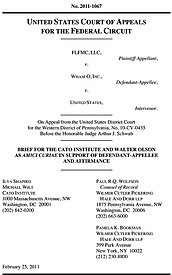FLFMC, LLC v. Wham‑O, Inc.
Learn more about Cato’s Amicus Briefs Program.
Recognizing an opportunity to make quick and easy money, private attorneys have been suing companies under the False Marking Statute, 35 U.S.C. § 292. This law allows any person to sue to enforce a federal criminal statute that prohibits anyone from labeling an unpatented product with a patent number or to advertise a product with a patent number that is not actually patented. The penalty for violating this law is $500 per offense, which has been interpreted to mean each and every product falsely marked. For instance, if a business is charged with falsely marking 100,000 products, it could be liable for $50,000,000. Private attorneys suing under this statute seek massive amounts in damages and then try to settle with the defendant for a fraction of that cost (still a large amount of money). Companies often settle even if the case against them has little merit because they do not want to risk such a massive amount in damages. The longtime toy manufacturer Wham‑O, however, successfully defended such a lawsuit in court, provoking the plaintiffs’ lawyers to appeal to the Federal Circuit (the only appellate court below the Supreme Court that can hear patent cases). Cato, along with our senior fellow Walter Olson — who has studied these patent marking cases — filed an amicus brief supporting Wham‑O on constitutional grounds. We argue that the False Marking Statute fails to give the executive branch, through the attorney general, control over the enforcement actions brought at its behest. By allowing any person to sue and then receive half of the damages, the law abrogates the executive power to enforce the law and places it in the exclusive hands of the private attorney. In the 1988 case of Morrison v. Olson, the Supreme Court upheld the independent counsel statute because it gave the Attorney General “sufficient control” over the independent counsel’s hiring, firing, and the scope of their investigation. Other courts have held that for a private person to prosecute what is called a “qui tam” action under the False Claims Act — essentially stepping into the shoes of the government — the government must maintain “sufficient control” over the litigation. The False Marking Statute does not provide sufficient control, or any control, and therefore violates Article II’s “Take Care Clause,” the font of the executive branch’s enforcement duties. Ultimately, the separation of powers, the foundation for the governmental structure created by the Framers, ensures that laws are enforced by someone accountable to the people, the Executive. The False Marking Statute divests the president of this authority, so the Federal Circuit should strike it down as violating the Constitution’s separation-of-powers structure.

This work is licensed under a Creative Commons Attribution-NonCommercial-ShareAlike 4.0 International License.


